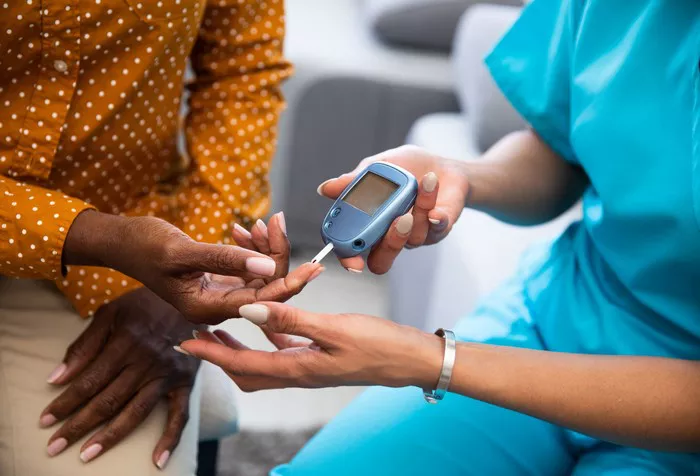Diabetes mellitus, commonly referred to as diabetes, is a chronic medical condition characterized by elevated levels of blood glucose (sugar) due to the body’s inability to produce enough insulin or to use insulin effectively. Insulin is a hormone produced by the pancreas that helps regulate blood glucose levels. When this system is disrupted, it can lead to serious health complications. Understanding what blood glucose level constitutes diabetes is essential for diagnosis, management, and prevention of this pervasive disease.
The Basics of Blood Glucose
Blood glucose levels refer to the amount of sugar present in the bloodstream. This sugar is derived from the foods we eat, and it is the body’s primary source of energy. Normally, blood glucose levels are tightly regulated by insulin, ensuring that they remain within a healthy range. When these levels are consistently too high or too low, it indicates an underlying health issue.
Normal Blood Glucose Levels
In individuals without diabetes, blood glucose levels are generally maintained within a narrow range:
- Fasting Blood Glucose: This is the blood glucose level after an individual has not eaten for at least 8 hours. For a non-diabetic person, fasting blood glucose typically ranges between 70 and 99 mg/dL (milligrams per deciliter).
- Postprandial Blood Glucose: This is the blood glucose level measured two hours after eating. In non-diabetic individuals, postprandial blood glucose should be less than 140 mg/dL.
- Random Blood Glucose: This can be measured at any time of the day, regardless of when the last meal was consumed. For non-diabetics, random blood glucose levels usually range from 70 to 140 mg/dL.
Diagnosing Diabetes
The diagnosis of diabetes is based on specific blood glucose criteria. These criteria have been established by various health organizations, including the American Diabetes Association (ADA) and the World Health Organization (WHO). The primary tests used to diagnose diabetes are:
- Fasting Plasma Glucose (FPG) Test
- Oral Glucose Tolerance Test (OGTT)
- Hemoglobin A1c (HbA1c) Test
- Random Plasma Glucose Test
Fasting Plasma Glucose (FPG) Test
The FPG test measures blood glucose after an individual has fasted for at least 8 hours. This test is commonly used for diagnosing diabetes and prediabetes. The results are interpreted as follows:
- Normal: Fasting blood glucose less than 100 mg/dL.
- Prediabetes: Fasting blood glucose between 100 and 125 mg/dL.
- Diabetes: Fasting blood glucose 126 mg/dL or higher on two separate occasions.
Oral Glucose Tolerance Test (OGTT)
The OGTT measures blood glucose levels before and two hours after consuming a sugary drink. This test is more sensitive than the FPG test and is often used to diagnose gestational diabetes. The results are interpreted as follows:
- Normal: Two-hour blood glucose less than 140 mg/dL.
- Prediabetes: Two-hour blood glucose between 140 and 199 mg/dL.
- Diabetes: Two-hour blood glucose 200 mg/dL or higher.
Hemoglobin A1c (HbA1c) Test
The HbA1c test measures the percentage of glucose that is bound to hemoglobin in the blood. This test provides an average blood glucose level over the past 2 to 3 months. The results are interpreted as follows:
- Normal: HbA1c less than 5.7%.
- Prediabetes: HbA1c between 5.7% and 6.4%.
- Diabetes: HbA1c 6.5% or higher.
Random Plasma Glucose Test
The random plasma glucose test can be conducted at any time, without fasting. It is often used when symptoms of diabetes are present. A random blood glucose level of 200 mg/dL or higher, along with symptoms of diabetes (such as increased thirst, frequent urination, and unexplained weight loss), suggests diabetes.
The Significance of Prediabetes
Prediabetes is a condition where blood glucose levels are higher than normal but not yet high enough to be classified as diabetes. It is a critical stage, as individuals with prediabetes are at a higher risk of developing type 2 diabetes, heart disease, and stroke. Early detection and intervention can prevent or delay the onset of diabetes.
Individuals with prediabetes can often return their blood glucose levels to the normal range through lifestyle changes, such as:
- Healthy Eating: Consuming a balanced diet rich in fruits, vegetables, whole grains, and lean proteins while limiting sugary and high-fat foods.
- Regular Physical Activity: Engaging in at least 150 minutes of moderate-intensity aerobic activity per week, such as brisk walking or cycling.
- Weight Loss: Losing 5% to 10% of body weight can significantly reduce the risk of developing diabetes.
- Regular Monitoring: Keeping track of blood glucose levels to ensure they remain within a healthy range.
Types of Diabetes
Diabetes is classified into several types, each with distinct causes and characteristics. The most common types are type 1, type 2, and gestational diabetes.
Type 1 Diabetes
Type 1 diabetes, previously known as juvenile diabetes or insulin-dependent diabetes, is an autoimmune condition. The immune system mistakenly attacks and destroys the insulin-producing beta cells in the pancreas. As a result, the body cannot produce insulin, leading to high blood glucose levels. Type 1 diabetes usually develops in children and young adults, although it can occur at any age. It accounts for about 5-10% of all diabetes cases.
Symptoms of Type 1 Diabetes:
- Frequent urination
- Excessive thirst
- Unexplained weight loss
- Extreme hunger
- Fatigue
- Blurred vision
- Slow-healing sores
Management of Type 1 Diabetes:
- Insulin Therapy: Individuals with type 1 diabetes require lifelong insulin therapy to regulate blood glucose levels.
- Blood Glucose Monitoring: Regular monitoring of blood glucose levels is essential to prevent complications.
- Healthy Lifestyle: Maintaining a balanced diet and regular physical activity is crucial for overall health and well-being.
Type 2 Diabetes
Type 2 diabetes, previously known as adult-onset diabetes or non-insulin-dependent diabetes, is the most common form of diabetes, accounting for about 90-95% of all cases. It occurs when the body becomes resistant to insulin or when the pancreas cannot produce enough insulin to maintain normal blood glucose levels. Type 2 diabetes is strongly associated with lifestyle factors, such as obesity, physical inactivity, and poor diet.
Symptoms of Type 2 Diabetes:
- Increased thirst and urination
- Unexplained weight loss
- Fatigue
- Blurred vision
- Slow-healing sores
- Frequent infections
Management of Type 2 Diabetes:
- Healthy Eating: A balanced diet that includes whole grains, fruits, vegetables, lean proteins, and healthy fats is essential.
- Physical Activity: Regular exercise helps improve insulin sensitivity and control blood glucose levels.
- Weight Management: Maintaining a healthy weight is crucial for managing type 2 diabetes.
- Medications: Various oral and injectable medications are available to help control blood glucose levels.
- Blood Glucose Monitoring: Regular monitoring is necessary to ensure blood glucose levels remain within target ranges.
Gestational Diabetes
Gestational diabetes occurs during pregnancy when the body cannot produce enough insulin to meet the increased demands. It usually develops in the second or third trimester and affects about 7% of pregnancies. While gestational diabetes typically resolves after childbirth, it increases the risk of developing type 2 diabetes later in life.
Risk Factors for Gestational Diabetes:
- Being overweight or obese
- Having a family history of diabetes
- Being over the age of 25
- Having previously given birth to a baby weighing more than 9 pounds
- Having had gestational diabetes in a previous pregnancy
Management of Gestational Diabetes:
- Healthy Eating: Consuming a balanced diet that includes a variety of nutrients and limits sugary foods.
- Physical Activity: Regular exercise helps manage blood glucose levels.
- Blood Glucose Monitoring: Frequent monitoring is necessary to ensure levels remain within target ranges.
- Medications: In some cases, insulin or other medications may be needed to control blood glucose levels.
Complications of Diabetes
Poorly managed diabetes can lead to a range of serious complications, affecting various organs and systems in the body. These complications can significantly impact the quality of life and increase the risk of premature death.
Cardiovascular Complications
Diabetes significantly increases the risk of cardiovascular diseases, including heart attack, stroke, and peripheral artery disease. High blood glucose levels can damage blood vessels and nerves that control the heart, leading to cardiovascular complications.
Prevention and Management:
- Healthy Lifestyle: A balanced diet, regular exercise, and weight management are crucial.
- Medications: Managing blood pressure, cholesterol levels, and blood glucose levels with medications can reduce the risk of cardiovascular diseases.
- Regular Check-Ups: Regular medical check-ups can help detect and manage cardiovascular risks early.
Neuropathy
Diabetes can cause nerve damage (neuropathy), leading to symptoms such as pain, tingling, and loss of sensation in the extremities (especially the feet). Severe neuropathy can lead to infections and amputations.
Prevention and Management:
- Blood Glucose Control: Keeping blood glucose levels within target ranges can prevent or delay the onset of neuropathy.
- Foot Care: Regular foot inspections and proper foot care are essential to prevent complications.
- Medications: Pain management and medications to address specific symptoms of neuropathy may be necessary.
Nephropathy
Diabetes is a leading cause of kidney disease (nephropathy). High blood glucose levels can damage the kidneys’ filtering system, leading to kidney failure over time.
Prevention and Management:
- Blood Glucose Control: Maintaining target blood glucose levels can prevent or delay kidney damage.
- Blood Pressure Control: Managing blood pressure is crucial for kidney health.
- Medications: Medications that protect the kidneys and manage complications may be prescribed.
- Regular Monitoring: Regular kidney function tests are essential to detect early signs of nephropathy.
Retinopathy
Diabetes can cause damage to the blood vessels in the retina (retinopathy), leading to vision problems and blindness.
Prevention and Management:
- Blood Glucose Control: Maintaining target blood glucose levels can prevent or delay retinopathy.
- Regular Eye Exams: Annual comprehensive eye exams are essential to detect early signs of retinopathy.
- Treatment: Laser therapy, injections, and surgery may be necessary to manage advanced retinopathy.
Living with Diabetes
Living with diabetes requires a proactive approach to health management. With proper care and lifestyle adjustments, individuals with diabetes can lead healthy, fulfilling lives.
Key Strategies for Managing Diabetes:
- Education: Understanding diabetes and its management is crucial for effective control.
- Healthy Eating: A balanced diet that meets individual needs and preferences is essential.
- Physical Activity: Regular exercise helps control blood glucose levels and improve overall health.
- Blood Glucose Monitoring: Frequent monitoring helps ensure levels remain within target ranges.
- Medication Adherence: Taking medications as prescribed is crucial for managing diabetes.
- Regular Medical Check-Ups: Regular visits to healthcare providers help monitor and manage complications.
See also: What Glucose Meters Medicare Covers
Conclusion
Understanding the blood glucose levels that constitute diabetes is fundamental for diagnosis, management, and prevention. By recognizing the thresholds and implementing appropriate lifestyle changes and medical interventions, individuals can effectively manage their condition and reduce the risk of complications. Ongoing education, support, and regular monitoring are essential components of living well with diabetes. As research continues to advance, new strategies and treatments will further enhance the quality of life for those affected by this chronic condition.
Related topics:
What’s the Minimum Fasting Sugar Level for Optimal Health

























